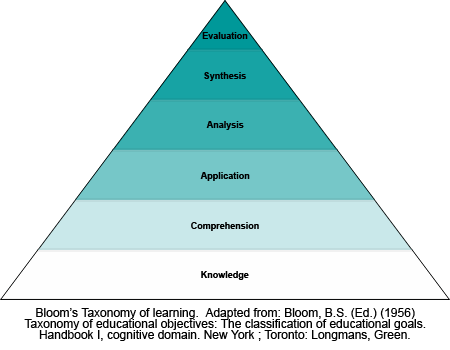Introductory Lecture
Slides
When we stick it all together…
Bloom’s Taxonomy is a well known, yet often poorly understood classification of cognitive skills. The original version (now revised) places synthesis and evaluation at the top of a hierarchal pyramid; considering them to be the most difficult and critical skills to develop.
And while there is some dispute with regards to such a linear representation, another taxonomy: SOLO, also places synthesis and evaluation within the latter stages of higher-order thinking.
Evaluation is defined as making a judgement about the value or worth of something. Within the context of learning and academic reading/research, to evaluate is to form conclusions based on information that you have gathered/analysed; a process in which you have already engaged both in week three and week four. Evaluation itself is a relatively easy process, in that we make judgements all of the time. However, ‘academic’ evaluation must be underpinned by analysis and synthesis to give it credibility.
Synthesis itself is arguably a more complex and challenging process; combining multiple sources in order to form theories, patterns and develop a fuller understanding. It requires a mindful approach and asks you to look for and identify links between sources. The outcome should be a more cogent understanding of a topic or argument; and sometimes even a new idea or theory.
Both synthesis and evaluation are placed high up in the Open University’s Undergraduate Levels Framework as well as featuring in both the ANCIL and SCONUL models of Information Literacy, suggesting that they are considered to be integral to successful learning in Higher Education and life-long learning. Moreover, I personally see them as corner stones of academic research and writing. Investigation and analysis are only useful as far as they can be used to support the processes of synthesis and evaluation.
Reading
- Atherton J S (2011) Learning and Teaching; SOLO taxonomy [Webpage]
- RMIT: Synthesising – Online Tutorial [Guide]
- SCONUL Working Group on Information Literacy (2011) The SCONUL Seven Pillars of Information Literacy, Core Model for Higher Education [Publication]
- Secker, J. and Coonan, E. (2011) A New Curriculum for Information Literacy, Arcadia Project, Cambridge University Library [Publication]
- Wikipedia contributors (2013) Bloom’s Taxonomy, Wikipedia, The Free Encyclopaedia [Article]
Twitter Discussion
Archive – Wednesday 10th April
Assignments:
1. Make a collaborative video in a small group under the title: Chicken or Egg?
- You should draw upon your research and reading about about Chickens and Eggs.
- It should reflect the conclusions that you have drawn along the way and synthesise those ideas.
2. Write a blog post reflecting on:
- the process of creating and editing the video.
- how this activity has contributed to your development as an in(ter)dependent learner.
3. Read and comment on the blog posts of the 3-4 members of your comment group. (Discuss their responses to the questions and share your learning from the week)
Guidance for making the video:
- You will be assigned a Google Doc. This is an area to discuss and plan your response. This could include ideas, script, organisation, sharing of useful links, etc…
- Each of you must contribute 30-40 seconds of video. It can be as simple as talking into your webcam or it could be something more involved with images, background music, etc…
- The maximum length for the video is two minutes.
- You can use Dropbox (instructions here) to collate your videos
- One person in the group must take responsibility for piecing together and editing the final video. This must be published to YouTube and embedded in your blog posts.
- YouTube Video Editor is perfect for this task, and here is a guide to get you started. Although, you can use whatever equipment you want.
- A couple of reminders:
- Please do not use any copyrighted material. Your own or ‘creative commons‘ material only please.
- You do not have to appear on camera if you do not want to. I know that some of you may be a bit camera shy. Please look at this video that I contributed to an online course I participated in. It’s my voice narrating a series of slides: Learning is Messy (#MOOCMOOC)
